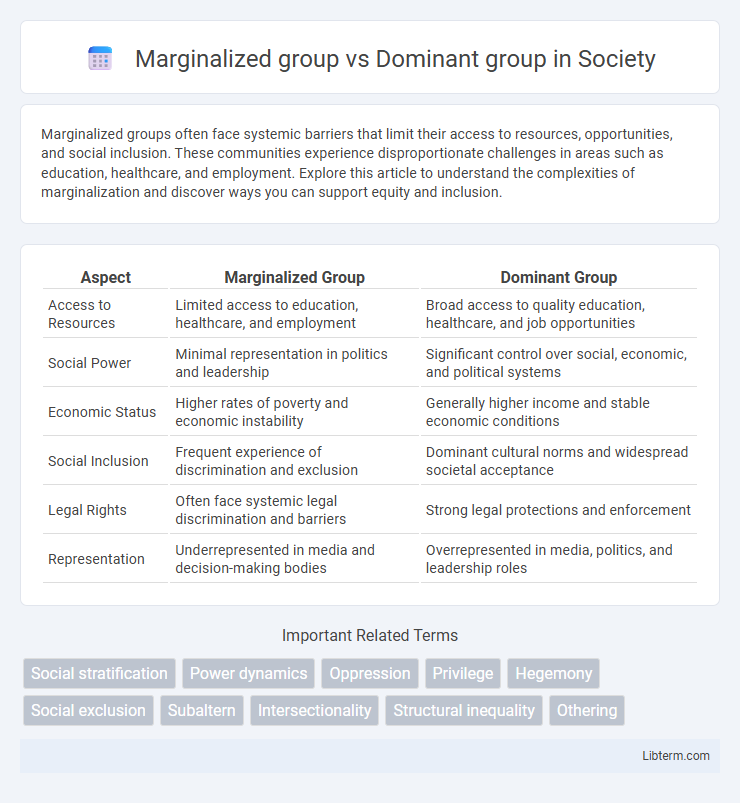Marginalized groups often face systemic barriers that limit their access to resources, opportunities, and social inclusion. These communities experience disproportionate challenges in areas such as education, healthcare, and employment. Explore this article to understand the complexities of marginalization and discover ways you can support equity and inclusion.
Table of Comparison
| Aspect | Marginalized Group | Dominant Group |
|---|---|---|
| Access to Resources | Limited access to education, healthcare, and employment | Broad access to quality education, healthcare, and job opportunities |
| Social Power | Minimal representation in politics and leadership | Significant control over social, economic, and political systems |
| Economic Status | Higher rates of poverty and economic instability | Generally higher income and stable economic conditions |
| Social Inclusion | Frequent experience of discrimination and exclusion | Dominant cultural norms and widespread societal acceptance |
| Legal Rights | Often face systemic legal discrimination and barriers | Strong legal protections and enforcement |
| Representation | Underrepresented in media and decision-making bodies | Overrepresented in media, politics, and leadership roles |
Understanding Marginalized and Dominant Groups
Marginalized groups experience social, economic, and political exclusion due to systemic inequalities, leading to limited access to resources, power, and opportunities. Dominant groups maintain structural advantages through control of institutions, cultural norms, and policymaking, perpetuating disparities. Understanding these dynamics is crucial for addressing social injustice and promoting equity.
Historical Contexts of Power and Inequality
Historical contexts of power reveal that dominant groups have systematically maintained control over resources, political institutions, and cultural narratives, resulting in the marginalization of subordinate communities. Marginalized groups, often subjected to exclusion and discrimination, experience limited access to socioeconomic opportunities due to entrenched inequalities rooted in colonialism, slavery, and institutionalized racism. Examining these power dynamics through historical analysis highlights the persistent impact of hegemonic dominance on social stratification and intergroup relations.
Characteristics of Marginalized Groups
Marginalized groups often experience limited access to resources, social exclusion, and systemic discrimination based on race, ethnicity, gender, or socioeconomic status. These groups face barriers to political representation, economic opportunity, and educational attainment. Their lived experiences frequently include social stigmatization, unequal power dynamics, and restricted participation in decision-making processes.
Characteristics of Dominant Groups
Dominant groups possess greater access to power, resources, and social privileges, enabling them to influence societal norms and policy decisions. They often maintain control through institutional structures, cultural dominance, and economic advantages that perpetuate inequality. Their characteristics include social prestige, political influence, and the ability to enforce cultural values that marginalize subordinate groups.
Social Dynamics Between Groups
Social dynamics between marginalized groups and dominant groups involve power imbalances where dominant groups control resources, influence norms, and enforce societal rules that often marginalize others. Marginalized groups experience limited access to opportunities, social exclusion, and systemic discrimination, affecting their social mobility and representation. Interactions between these groups are shaped by historical inequalities, institutional biases, and ongoing struggles for equity and recognition.
Systemic Barriers Faced by Marginalized Groups
Marginalized groups encounter systemic barriers rooted in institutional policies, social norms, and economic structures that restrict access to education, healthcare, and employment opportunities. These barriers perpetuate inequality by reinforcing power imbalances maintained by dominant groups who benefit from existing socio-political frameworks. Addressing systemic discrimination requires targeted policy reforms and inclusive practices to dismantle structural obstacles that marginalize vulnerable populations.
Privilege and Power Structures
Marginalized groups experience systemic disadvantages due to entrenched power structures that favor dominant groups, granting them unearned privileges in social, economic, and political spheres. These privileges manifest in heightened access to resources, decision-making authority, and cultural representation, reinforcing inequalities. Power dynamics perpetuate marginalization by normalizing dominance and limiting the agency and opportunities of subordinated communities.
Impact of Marginalization on Well-being
Marginalization often results in limited access to vital resources such as healthcare, education, and employment opportunities, severely impacting the mental and physical well-being of marginalized groups. Chronic stress, social exclusion, and systemic discrimination contribute to higher rates of anxiety, depression, and chronic illnesses within these populations. Conversely, dominant groups typically benefit from social privileges that promote overall health and life satisfaction.
Strategies for Empowerment and Inclusion
Marginalized groups can enhance empowerment and inclusion by implementing community-led initiatives that promote access to education, healthcare, and political representation. Dominant groups play a crucial role in dismantling systemic barriers through equitable policy reforms and fostering inclusive environments that value diversity. Collaborative partnerships between marginalized and dominant groups strengthen social cohesion and ensure sustained progress toward equality.
Building Bridges: Towards Equity and Justice
Marginalized groups often face systemic barriers that limit access to resources, opportunities, and political power, while dominant groups typically enjoy social, economic, and cultural privileges. Building bridges between these groups requires intentional dialogue, inclusive policies, and equitable resource distribution to dismantle structural inequalities. Fostering mutual understanding and collaboration promotes social justice by empowering marginalized communities and reshaping dominant group narratives towards equity.
Marginalized group Infographic

 libterm.com
libterm.com